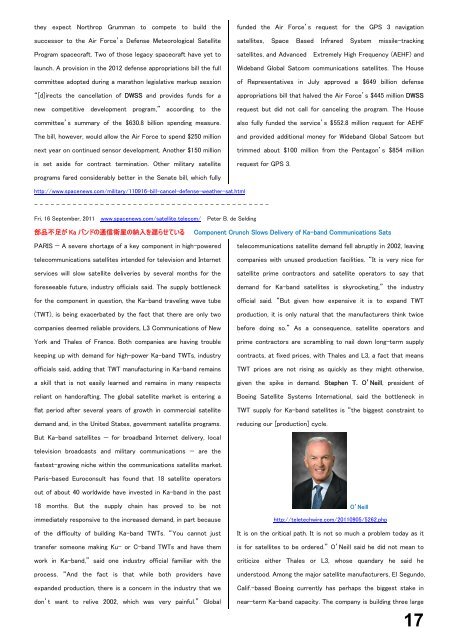24 - Space-Library
24 - Space-Library
24 - Space-Library
You also want an ePaper? Increase the reach of your titles
YUMPU automatically turns print PDFs into web optimized ePapers that Google loves.
they expect Northrop Grumman to compete to build the<br />
successor to the Air Force’s Defense Meteorological Satellite<br />
Program spacecraft. Two of those legacy spacecraft have yet to<br />
launch. A provision in the 2012 defense appropriations bill the full<br />
committee adopted during a marathon legislative markup session<br />
“[d]irects the cancellation of DWSS and provides funds for a<br />
new competitive development program,” according to the<br />
committee’s summary of the $630.8 billion spending measure.<br />
The bill, however, would allow the Air Force to spend $250 million<br />
next year on continued sensor development. Another $150 million<br />
is set aside for contract termination. Other military satellite<br />
funded the Air Force’s request for the GPS 3 navigation<br />
satellites, <strong>Space</strong> Based Infrared System missile-tracking<br />
satellites, and Advanced Extremely High Frequency (AEHF) and<br />
Wideband Global Satcom communications satellites. The House<br />
of Representatives in July approved a $649 billion defense<br />
appropriations bill that halved the Air Force’s $445 million DWSS<br />
request but did not call for canceling the program. The House<br />
also fully funded the service’s $552.8 million request for AEHF<br />
and provided additional money for Wideband Global Satcom but<br />
trimmed about $100 million from the Pentagon’s $854 million<br />
request for GPS 3.<br />
programs fared considerably better in the Senate bill, which fully<br />
http://www.spacenews.com/military/110916-bill-cancel-defense-weather-sat.html<br />
- - - - - - - - - - - - - - - - - - - - - - - - - - - - - - - - - - - - - - - - - - -<br />
Fri, 16 September, 2011 www.spacenews.com/satellite_telecom/ Peter B. de Selding<br />
部 品 不 足 が Ka バンドの 通 信 衛 星 の 納 入 を 遅 らせている<br />
Component Crunch Slows Delivery of Ka-band Communications Sats<br />
PARIS — A severe shortage of a key component in high-powered<br />
telecommunications satellites intended for television and Internet<br />
services will slow satellite deliveries by several months for the<br />
foreseeable future, industry officials said. The supply bottleneck<br />
for the component in question, the Ka-band traveling wave tube<br />
(TWT), is being exacerbated by the fact that there are only two<br />
companies deemed reliable providers, L3 Communications of New<br />
York and Thales of France. Both companies are having trouble<br />
keeping up with demand for high-power Ka-band TWTs, industry<br />
officials said, adding that TWT manufacturing in Ka-band remains<br />
a skill that is not easily learned and remains in many respects<br />
reliant on handcrafting. The global satellite market is entering a<br />
flat period after several years of growth in commercial satellite<br />
demand and, in the United States, government satellite programs.<br />
telecommunications satellite demand fell abruptly in 2002, leaving<br />
companies with unused production facilities. “It is very nice for<br />
satellite prime contractors and satellite operators to say that<br />
demand for Ka-band satellites is skyrocketing,” the industry<br />
official said. “But given how expensive it is to expand TWT<br />
production, it is only natural that the manufacturers think twice<br />
before doing so.” As a consequence, satellite operators and<br />
prime contractors are scrambling to nail down long-term supply<br />
contracts, at fixed prices, with Thales and L3, a fact that means<br />
TWT prices are not rising as quickly as they might otherwise,<br />
given the spike in demand. Stephen T. O’Neill, president of<br />
Boeing Satellite Systems International, said the bottleneck in<br />
TWT supply for Ka-band satellites is “the biggest constraint to<br />
reducing our [production] cycle.<br />
But Ka-band satellites — for broadband Internet delivery, local<br />
television broadcasts and military communications — are the<br />
fastest-growing niche within the communications satellite market.<br />
Paris-based Euroconsult has found that 18 satellite operators<br />
out of about 40 worldwide have invested in Ka-band in the past<br />
18 months. But the supply chain has proved to be not<br />
immediately responsive to the increased demand, in part because<br />
of the difficulty of building Ka-band TWTs. “You cannot just<br />
transfer someone making Ku- or C-band TWTs and have them<br />
work in Ka-band,” said one industry official familiar with the<br />
process. “And the fact is that while both providers have<br />
expanded production, there is a concern in the industry that we<br />
don’t want to relive 2002, which was very painful.” Global<br />
O’Neill<br />
http://teletechwire.com/20110905/5262.php<br />
It is on the critical path. It is not so much a problem today as it<br />
is for satellites to be ordered.” O’Neill said he did not mean to<br />
criticize either Thales or L3, whose quandary he said he<br />
understood. Among the major satellite manufacturers, El Segundo,<br />
Calif.-based Boeing currently has perhaps the biggest stake in<br />
near-term Ka-band capacity. The company is building three large<br />
17
















